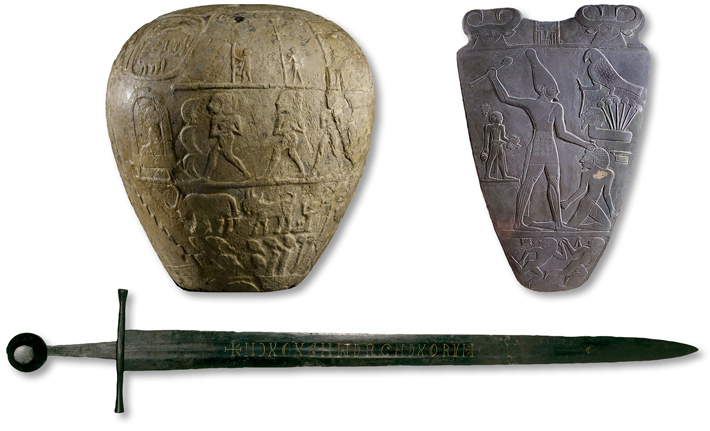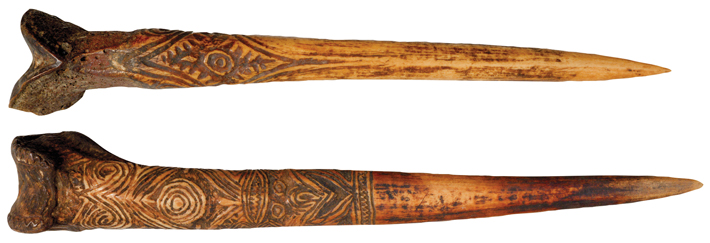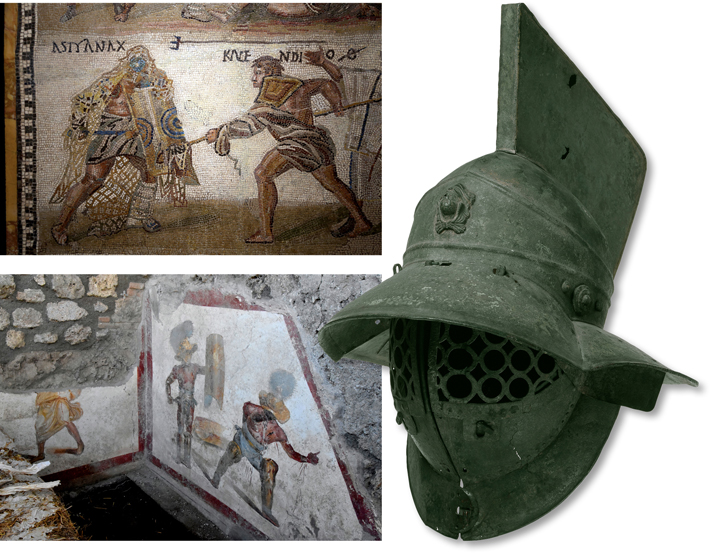Weapons
Ceremonial and Magic Weapons
By JASON URBANUS
Friday, April 10, 2020
 Weapons are, of course, instruments of violence. Occasionally, though, they assume symbolic importance that transcends their martial purpose and comes to represent the power and authority their possessors hold over others. At times, some ancient weapons were seen as mystical items, endowed with supernatural properties.
Weapons are, of course, instruments of violence. Occasionally, though, they assume symbolic importance that transcends their martial purpose and comes to represent the power and authority their possessors hold over others. At times, some ancient weapons were seen as mystical items, endowed with supernatural properties.
Maces were closely associated with the earliest Egyptian rulers. They could be used to crush an opponent’s skull in close combat but were also seen as important symbols of pharaohs’ strength and supremacy. Some ancient examples, such as the approximately 5,000-year-old mace-head of King Narmer, were not intended to be used in battle, but were explicitly designed to serve as ceremonial or votive objects. This mace-head was carved with scenes from Narmer’s life that emphasized his authority and the subjugation of his enemies.
In medieval Europe, some workshops attempted to imbue their swords with magical powers by inscribing the blades, as seen on a thirteenth-century weapon pulled from the Witham River in England. These often indecipherable messages, which include clearly Christian symbols, were presumably intended to invoke God’s protection in battle. They are part of a Germanic tradition dating to pre-Christian times in which magical runic symbols were etched onto blades.
 The symbolic and supernatural nature of ancient weapons is perhaps best embodied by bone daggers that were widely used in New Guinea. Traditionally, these lethal objects were made from the leg bones of cassowary birds. In special circumstances, though, they could be shaped from the femur of a fallen adversary or a deceased relative. “Human bone daggers were rare,” says Dartmouth College anthropologist Nathaniel Dominy. “To possess one, a man had to have killed another man in combat or have appropriated his dead father’s femur.” Recent research has demonstrated that these human bone daggers were stronger than their cassowary counterparts. They were also evocative symbols of the ferocity and prowess of those who wielded them. “These weapons were filled with substantial strength,” says Dominy. “They were manifestations of spiritual power and allowed the owner to lay claim to the rights and powers of the man who had surrendered the bone.”
The symbolic and supernatural nature of ancient weapons is perhaps best embodied by bone daggers that were widely used in New Guinea. Traditionally, these lethal objects were made from the leg bones of cassowary birds. In special circumstances, though, they could be shaped from the femur of a fallen adversary or a deceased relative. “Human bone daggers were rare,” says Dartmouth College anthropologist Nathaniel Dominy. “To possess one, a man had to have killed another man in combat or have appropriated his dead father’s femur.” Recent research has demonstrated that these human bone daggers were stronger than their cassowary counterparts. They were also evocative symbols of the ferocity and prowess of those who wielded them. “These weapons were filled with substantial strength,” says Dominy. “They were manifestations of spiritual power and allowed the owner to lay claim to the rights and powers of the man who had surrendered the bone.”
Gladiator Weapons
By JASON URBANUS
Friday, April 10, 2020
 Gladiatorial contests were wildly popular among the ancient Romans, drawing tens of thousands of spectators. At first, the bouts were simple affairs, fought between combatants lightly armed with swords or spears. But as these events grew more popular and involved a greater number of fighting pairs, the Romans boosted their entertainment value by pitting gladiators who specialized in different sets of weapons, armor, and fighting style against each other. This increased the unpredictability of a match’s outcome. For example, a secutor carried a short sword and a large shield and wore a rounded helmet that covered his entire head, except for two small eyeholes. A secutor often opposed a retiarius, who was equipped with a net in one hand and a long trident in the other. Other classes of gladiators included the dimachaerii, who carried two short curved blades; the equites, who fought on horseback; the essedarii, who rode chariots; and the laqueatores, who stalked their opponents with lassos and daggers.
Gladiatorial contests were wildly popular among the ancient Romans, drawing tens of thousands of spectators. At first, the bouts were simple affairs, fought between combatants lightly armed with swords or spears. But as these events grew more popular and involved a greater number of fighting pairs, the Romans boosted their entertainment value by pitting gladiators who specialized in different sets of weapons, armor, and fighting style against each other. This increased the unpredictability of a match’s outcome. For example, a secutor carried a short sword and a large shield and wore a rounded helmet that covered his entire head, except for two small eyeholes. A secutor often opposed a retiarius, who was equipped with a net in one hand and a long trident in the other. Other classes of gladiators included the dimachaerii, who carried two short curved blades; the equites, who fought on horseback; the essedarii, who rode chariots; and the laqueatores, who stalked their opponents with lassos and daggers.
While some ancient written sources describe these various types of gladiator, mosaics and frescoes capture their appearance. One such fresco was recently unearthed in a tavern in Pompeii. The vivid scene depicts two gladiators—a murmillo (“fish-man”) and a Traex (“Thracian”). The murmillo is recognizable by his visored helmet, right arm guard, left shin guard, large rectangular shield, and short sword. The Traex wore a similar wide-brimmed crested helmet, but carried a smaller shield and a short curved sword. He is portrayed wearing a characteristic protective belt and thigh-high greaves. In the Pompeian fresco, at least, the murmillo clearly has the edge—he is depicted triumphantly holding up his shield while blood gushes from wounds to his opponent’s wrist and chest.
Advertisement
Advertisement
IN THIS ISSUE
Advertisement

Recent Issues
-
 May/June 2024
May/June 2024
-
 March/April 2024
March/April 2024
-
 January/February 2024
January/February 2024
-
 November/December 2023
November/December 2023
-
 September/October 2023
September/October 2023
-
 July/August 2023
July/August 2023
-
 May/June 2023
May/June 2023
-
 March/April 2023
March/April 2023
-
 January/February 2023
January/February 2023
-
 November/December 2022
November/December 2022
-
 September/October 2022
September/October 2022
-
 July/August 2022
July/August 2022
-
 May/June 2022
May/June 2022
-
 March/April 2022
March/April 2022
-
 January/February 2022
January/February 2022
-
 November/December 2021
November/December 2021
-
 September/October 2021
September/October 2021
-
 July/August 2021
July/August 2021
-
 May/June 2021
May/June 2021
-
 March/April 2021
March/April 2021
-
 January/February 2021
January/February 2021
-
 November/December 2020
November/December 2020
-
 September/October 2020
September/October 2020
-
 July/August 2020
July/August 2020
-
 May/June 2020
May/June 2020
-
 March/April 2020
March/April 2020
-
 January/February 2020
January/February 2020
-
 November/December 2019
November/December 2019
-
 September/October 2019
September/October 2019
-
 July/August 2019
July/August 2019
-
 May/June 2019
May/June 2019
-
 March/April 2019
March/April 2019
-
 January/February 2019
January/February 2019
-
 November/December 2018
November/December 2018
-
 September/October 2018
September/October 2018
-
 July/August 2018
July/August 2018
-
 May/June 2018
May/June 2018
-
 March/April 2018
March/April 2018
-
 January/February 2018
January/February 2018
-
 November/December 2017
November/December 2017
-
 September/October 2017
September/October 2017
-
 July/August 2017
July/August 2017
-
 May/June 2017
May/June 2017
-
 March/April 2017
March/April 2017
-
 January/February 2017
January/February 2017
-
 November/December 2016
November/December 2016
-
 September/October 2016
September/October 2016
-
 July/August 2016
July/August 2016
-
 May/June 2016
May/June 2016
-
 March/April 2016
March/April 2016
-
 January/February 2016
January/February 2016
-
 November/December 2015
November/December 2015
-
 September/October 2015
September/October 2015
-
 July/August 2015
July/August 2015
-
 May/June 2015
May/June 2015
-
 March/April 2015
March/April 2015
-
 January/February 2015
January/February 2015
-
 November/December 2014
November/December 2014
-
 September/October 2014
September/October 2014
-
 July/August 2014
July/August 2014
-
 May/June 2014
May/June 2014
-
 March/April 2014
March/April 2014
-
 January/February 2014
January/February 2014
-
 November/December 2013
November/December 2013
-
 September/October 2013
September/October 2013
-
 July/August 2013
July/August 2013
-
 May/June 2013
May/June 2013
-
 March/April 2013
March/April 2013
-
 January/February 2013
January/February 2013
-
 November/December 2012
November/December 2012
-
 September/October 2012
September/October 2012
-
 July/August 2012
July/August 2012
-
 May/June 2012
May/June 2012
-
 March/April 2012
March/April 2012
-
 January/February 2012
January/February 2012
-
 November/December 2011
November/December 2011
-
 September/October 2011
September/October 2011
-
 July/August 2011
July/August 2011
-
 May/June 2011
May/June 2011
-
 March/April 2011
March/April 2011
-
 January/February 2011
January/February 2011
Advertisement






